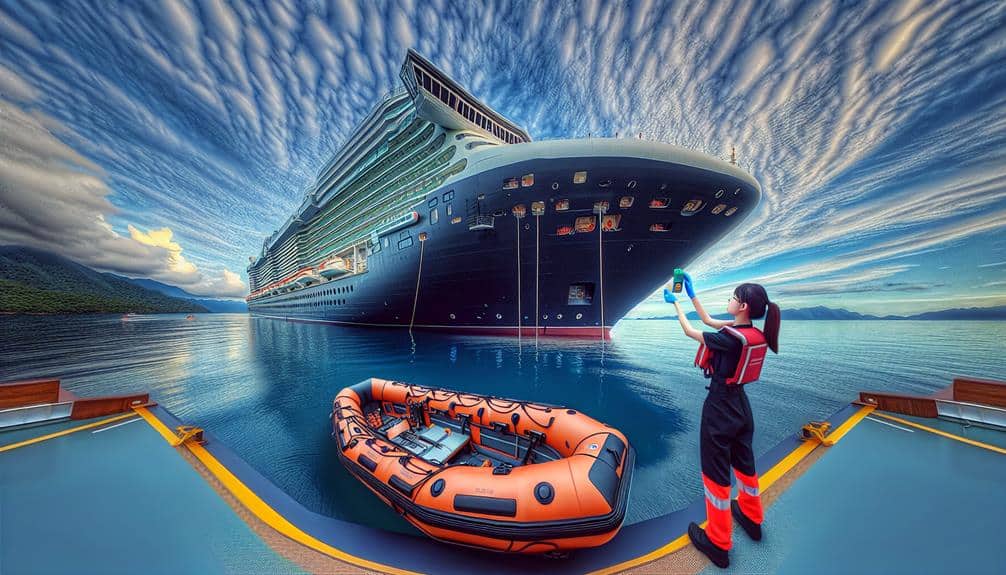Ensuring the safety of passengers and crew on cruise ships demands strict adherence to essential lifeboat maintenance regulations. Regular maintenance is pivotal for emergency readiness and cost-effective operations. Proper upkeep enhances risk management and ensures compliance with maritime standards. Neglecting maintenance can lead to financial losses and jeopardize safety. Monitoring safety protocols and crew training are paramount for swift emergency response. Maintenance checks and drills address potential issues promptly. Upholding regulations not only promotes safety onboard but also maintains operational efficiency. Stick to manufacturer guidelines and industry standards for a proactive maintenance strategy that minimizes risks and downtime.
Key Points
- Ensures safety during emergencies
- Mitigates risks and complies with regulations
- Enhances passenger and crew safety
- Prevents financial and legal consequences
- Maintains operational efficiency and readiness
Importance of Lifeboat Maintenance
Regular maintenance of lifeboats is essential for ensuring the safety and readiness of cruise ships in emergency situations. Neglecting this aspect can have significant cost implications and jeopardize effective risk management protocols. By adhering to a strict maintenance schedule, cruise ship operators can mitigate potential risks associated with lifeboat malfunctions, ultimately enhancing passenger safety and ensuring compliance with maritime regulations.
Cost implications arise when lifeboats aren't adequately maintained. Emergency repairs and replacements can be exorbitant compared to the routine maintenance costs incurred. Additionally, failure to properly upkeep lifeboats can lead to operational disruptions, affecting the overall efficiency of emergency response procedures. Investing in regular maintenance not only reduces the financial burden of unexpected issues but also contributes to a proactive approach in risk management.
In the domain of risk management, maintaining lifeboats is paramount. A well-maintained lifeboat fleet enhances the preparedness of a cruise ship in emergency scenarios, reducing the likelihood of accidents and improving the vessel's overall safety standards. By prioritizing maintenance, cruise ship operators demonstrate a commitment to safeguarding passengers and crew, thereby aligning with industry best practices for risk mitigation.
Compliance With Safety Standards
Adhering to stringent safety standards is essential for ensuring the operational integrity and emergency preparedness of cruise ships. Regulatory compliance and risk assessment are vital components in maintaining a safe environment onboard. Here are four key aspects to focus on when focusing on compliance with safety standards:
- Continuous Monitoring: Regularly assess and update safety protocols to meet evolving regulatory requirements and guarantee the highest level of compliance.
- Comprehensive Training Programs: Implement thorough training sessions for crew members to enhance emergency preparedness and equip them with the necessary skills to handle various scenarios effectively.
- Routine Equipment Inspections: Conduct frequent inspections of lifeboats, life rafts, and other safety equipment to verify their integrity and functionality in case of emergencies.
- Emergency Response Drills: Organize regular drills to test the crew's response in emergency situations, identifying areas for improvement and ensuring swift and coordinated actions during crises.
Strict adherence to safety standards not only promotes regulatory compliance but also enhances emergency preparedness and equipment integrity, ultimately safeguarding the lives of passengers and crew members.
Impact on Passenger and Crew Safety
Consistently monitoring and maintaining lifeboats is essential for ensuring the safety of passengers and crew members aboard cruise ships. Properly maintained lifeboats provide an important means of evacuation in emergencies, offering passengers reassurance that there are adequate resources in place to safeguard their safety.
Regular maintenance checks on lifeboats help to identify and address any potential issues promptly, ensuring that they're fully operational when needed most. Additionally, thorough crew training in lifeboat operations is crucial to guarantee a swift and effective response during emergencies. Crew members must be well-versed in launching procedures, safety protocols, and evacuation strategies to efficiently manage evacuation procedures and ensure the safety of all onboard.
Consequences of Neglecting Regulations
Failing to comply with regulations regarding lifeboat maintenance on cruise ships can lead to severe consequences, jeopardizing the safety of passengers and crew members. Neglecting these regulations can have serious repercussions, including:
- Financial implications: Non-compliance with lifeboat maintenance regulations can result in hefty fines and financial penalties. Repairing or replacing lifeboats due to neglect can be a costly affair for cruise ship companies.
- Legal consequences: Failure to adhere to lifeboat maintenance regulations can lead to legal action being taken against the cruise ship operators. This can tarnish the reputation of the company and result in legal battles that could have been avoided through proper maintenance procedures.
- Safety risks: Neglecting lifeboat maintenance can compromise the safety of passengers and crew in emergency situations. Inadequately maintained lifeboats may not function properly during evacuations, putting lives at risk.
- Operational disruptions: When lifeboats aren't properly maintained, it can lead to operational disruptions for the cruise ship. Delays in repairs or replacements can impact scheduled voyages, leading to dissatisfaction among passengers and financial losses for the company.
Ensuring Operational Efficiency
To guarantee operational efficiency on cruise ships, meticulous adherence to lifeboat maintenance protocols is imperative. Proper maintenance not only ensures that lifeboats are ready for immediate deployment in case of emergencies but also contributes to the overall cost effectiveness of ship operations. Regular inspections, testing, and servicing of lifeboat components are essential to prevent malfunctions that could hinder emergency preparedness. By following manufacturer guidelines and industry regulations, cruise ship operators can streamline lifeboat maintenance procedures, optimizing their functionality and reliability.
Implementing a proactive maintenance strategy not only minimizes downtime for lifeboats but also enhances the safety and security of passengers and crew. Well-maintained lifeboats are essential for swift evacuation during emergencies, underscoring the importance of prioritizing their upkeep. Investing in quality maintenance practices ultimately pays off by ensuring that lifeboats are in optimal condition, ready to perform effectively when called upon. Hence, a commitment to rigorous maintenance standards is fundamental in upholding operational efficiency and emergency preparedness on cruise ships.
Frequently Asked Questions
Are There Any Specific Training Requirements for Crew Members Responsible for Lifeboat Maintenance on Cruise Ships?
To guarantee compliance with safety standards, crew members responsible for lifeboat maintenance on cruise ships must undergo specific training requirements. This training equips them with the necessary skills to perform maintenance tasks effectively and safely.
How Often Should Lifeboat Drills Be Conducted to Ensure Passenger and Crew Readiness in Case of Emergency?
To guarantee passenger and crew readiness in emergencies, lifeboat drills should be conducted monthly. This frequency enhances emergency preparedness by familiarizing all with procedures and equipment, minimizing response time, and maximizing safety during evacuations.
What Are Some Common Challenges Faced by Cruise Ship Operators When It Comes to Complying With Lifeboat Maintenance Regulations?
Ensuring compliance with lifeboat maintenance regulations on cruise ships poses challenges like coordinating crew training and safety drills. Overcoming these obstacles is essential for passenger safety and the vessel's emergency preparedness.
How Do Lifeboat Maintenance Regulations Differ Between Countries and Regions, and How Can Cruise Ships Ensure They Are Meeting All Necessary Requirements?
When it comes to lifeboat maintenance regulations, understanding regional differences and ensuring compliance is essential. Conducting safety drills regularly and staying prepared for emergencies are key. Stay vigilant to meet all necessary requirements for safety at sea.
Is There a Standard Protocol for Conducting Inspections and Routine Maintenance on Lifeboats, and Who Is Responsible for Overseeing These Tasks Onboard a Cruise Ship?
To guarantee safety, onboard inspections and regular maintenance of lifeboats must follow a standard protocol. Oversight responsibilities fall on designated crew members. Compliance challenges arise due to regional differences in regulations, making it essential to stay informed and diligent.




